Sitting quietly, stock-still in the centre of the life drawing room, an unclothed model is gazing steadily at a spot on the wall. You can hear the sound of charcoal gently crumbling across drawing paper. All around you, people are concentrating intensely, trying to capture something real and true about this living, breathing, vulnerably naked person in front of them.
And suddenly you feel lost.
Filled with doubt.
What were you thinking, ever imagining that you could actually do this impossible life drawing thing?
Whether you’re a beginner at life drawing or an expert, the same anxious thoughts and feelings tend to come up.
Here are the 4 biggest life drawing fears that my students tend to experience:
- Where do I begin?
- Why isn’t it going right?
- Why can’t I draw as well as [artist X/ the person next to me / I did last week]?
- What’s the magic formula for getting my drawing to work?
Fear #1: Where do I begin?
You’ve got two options here.
Option #1: Start in the Middle
Try beginning with the middle. In a standing pose, this will probably be around the hips. In other poses ‘the middle’ will vary.
Why? Because starting in the middle allows you to work up, down, and across from that central area. It helps you see the whole, rather than a collection of the named, compartmentalised body parts. It also helps you hold an awareness of what’s happening in between the outlines, so you don’t just focus on the outer edges of the form.
Option #2: Follow Your Attention
Another way to begin is to start with whatever grabs your attention. It could be a certain sweep of an arm, the curve of a hip, a surprising and unexpected muscle being flexed, the shadows tracing the muscles and across the model’s back.
Your fascination will provide vital energy to fuel your drawing and give it a quality of excitement and intensity.
Fear #2: Why isn’t it going right?
We all have this thought. A lot!
Is it a useful thought to be having? Well… yes and no. It’s only useful if you can couple it with courage.
Tip: Have Courage!
What do I mean by courage? It might mean one, or all, of the following.
- Having the courage to ask for someone else’s opinion
- Having the courage to try to see the model/your drawing with fresh eyes
- Having the courage to try to forget everything you ever thought you knew, and try something new
- Having the courage to make some dramatic changes to your drawing (despite knowing that you run the risk of making it worse!)
Drawing with courage can feel exhilarating, alarming and wonderfully free.
Paying attention to the feelings you can experience through life drawing, rather than only being focused on the end-product, is a great way to really gain deeply from each life drawing session.
Fear #3: Why can’t I draw as well as [artist X/ the person next to me / I did last week]?
This is where you have the opportunity to get a bit ‘zen’ about things. 😉
Tip: Take a Zen-Inspired Attitude
See what happens when you stop wanting things to be different, and accept what is (or what seems to be).
Maybe you can’t draw as well as artist X (whatever ‘well’ means to you). Maybe things aren’t flowing for you the way they did in last week’s class.
And maybe that’s okay!
Accept how things are, and pay attention to the drawing you are making here and now.
Not your neighbour’s drawing. Not last week’s drawing. Not how Leonardo, or Goya, or Rembrandt would do it.
You are here, now.
What matters? You. The model. Your charcoal, your paper, your pencil or ink.
Being here, now.
Being who you are, in this place, on this day, in front of this incredible, unique, amazing person who is being so wonderfully generous as to share himself/herself, in all his or her vulnerability, imperfection and human frailty.
Fear #4: What’s the magic formula for getting my drawing to work?
Okay. Here’s my magic formula:
Be open to being surprised. And be compassionate.
Let me unpack that a little.
Tip: Be Open to Being Surprised
This is all about trying to forget everything you think you know about ‘how a person looks’.
You see, when you were a kid, figuring out how to draw a human body, you learned a few things. Like, people are symmetrical. Two arms, two legs, two eyes etc etc. Just imagine there’s a line down the centre, and make sure things are fairly even on each side.
The trouble is, the rule of symmetry only really applies if you are looking straight-on at someone who is standing straight and tall, weight evenly balanced on both feet, arms mirroring one another, face looking directly ahead.
But almost every pose that a real live model will do, will be asymmetrical (at least from most viewpoints).
You already know this, of course. But here’s the annoying thing: your brain will still be trying (unconsciously) to get you to even things out, and make things symmetrical! When you make sure to watch out for that tendency, and really try to look out for the surprising asymmetries that you see, your drawing will be much truer to the subject.
Being open to being surprised – really being curious – also means that you train yourself to notice and take in all the things about this particular pose, this particular model, that you could never have imagined if you’d just been asked to draw ‘a person’ from imagination.
Being surprised when you're life drawing - REALLY being surprised - feels magical. Share on XBeing surprised when you’re life drawing – really being surprised – feels magical. It’s what it’s all about!
Tip: Be Compassionate
Compassionate to whom? Yourself, first of all.
Because you know what trips people up the most when they are life drawing?
It isn’t lack of technical knowledge.
It isn’t that they weren’t taught enough about perspective, or shading, or human anatomy.
What trips people up the most is their own inner critical voice. The voice making negative, doom-laden comments about their inadequacy. And if you think that’s just ‘being realistic’, think again.
Because what really happens when people pay attention to their inner critic is that their creativity shuts down (or at least, gets severely limited).
And I believe that life drawing should be an experience of feeling (and being) creative.
And expressive, lively, authentic and real. A chance to challenge yourself to be ‘in the moment’, really present with this other person who is baring herself or himself to you.
Which brings me to the other aspect of compassion in life drawing: compassion for your model. Seeing him or her not just as a body, an object to draw, but also as someone who lives, and struggles, and longs for many of the same things as you do.
Attending to your awareness of your model’s humanity will enrich your experience of life drawing and will probably add an extra spark to your resulting drawings, too.
Read more about life drawing here
What are your top life drawing fears? And what have you found that helps? Post your thoughts in the comments below – I’d love to read them!
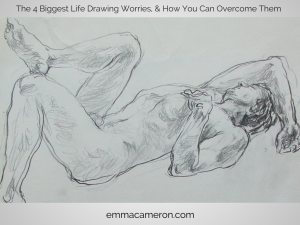

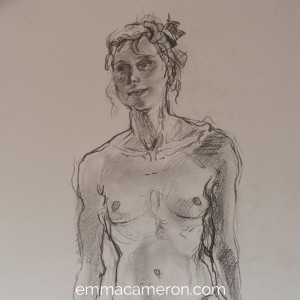
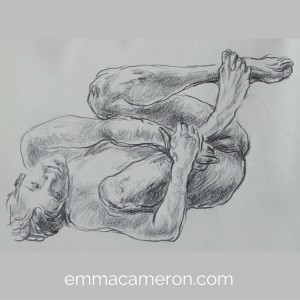
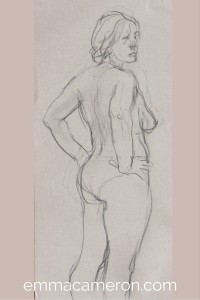
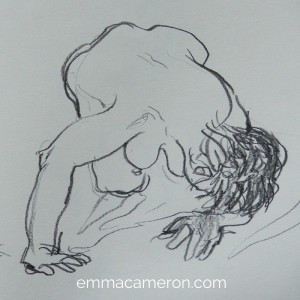
Dear Emma,
You have explained so well some of the vital feelings and key factors in a healthy approach to life drawing.
You are so right – a relaxed state of mind, “letting go” plus a sympathetic awareness of your subject are so helpful as starting points in achieving the right frame of mind, when life drawing.
Good luck with the wonderful classes you have planned.
Best Wishes
Angella x
Thanks for taking the time to respond, Angella. I know you’re a life drawing teacher yourself, and I’m delighted that you agree with the thoughts I offer in this article.
So good to read your wise words Emma! I loved doing your life drawing classes ! You may be surprised that I still use many of the techniques you taught me!
I am constantly surprised that a knee really is a pencil width away from the ear or, as my husband said whilst looking at my life drawing from yesterday’s session – is her nose really so close to her breast?
“Yes!” I replied!
Very well put Emma – all of the above happens and going through cycles of producing ‘poor’ drawings happens to us all I believe. Just as with painting (or anything else creative)to keep working and accept that this just happens. Often I squint (or half close my eyes) to get a simple impression of what the whole image looks and feels like and this can help to not get bogged down by details (such as facial features, fingers etc). On longer poses I’ll often do several quick drawings to try to get the flow or feel of the pose even if this contains inaccuracies of measurement etc. Drawing with both hands or using your other hand is a good way of loosening up and giving ‘surprise’ too………….where to stop……!!
Wonderful tips, Jane – thank you for sharing them!
Ah wonderful advice Emma
I wish you lived here !
I would take all your classes !
Thanks Kathleen!
Excellent teaching. And, of course, as you knew when writing it, (but that in no way invalidates it) a good set of lessons for life. Great stuff for which I’m grate ful.